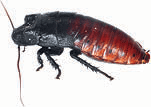

 Amir Ayali is a professor of zoology at Tel Aviv University and has been working with collaborating scientists at Princeton on the engineering principles used by cockroaches. Ayali is employing these principles in advanced robotics. What the researchers are doing is to look deeply into the neurological functioning to help them design robots “with a more compact build and greater efficiency in terms of energy, time, robustness and rigidity.”
Amir Ayali is a professor of zoology at Tel Aviv University and has been working with collaborating scientists at Princeton on the engineering principles used by cockroaches. Ayali is employing these principles in advanced robotics. What the researchers are doing is to look deeply into the neurological functioning to help them design robots “with a more compact build and greater efficiency in terms of energy, time, robustness and rigidity.”
Cockroaches have what is called “a tripod gate.” They are supported by at least three legs at all times when they are moving, providing greater stability on every kind of terrain. Ayali says their speed and agility is almost too good to be true. The researchers are interested in how sensory feedback from one leg is translated into the coordination of all the other legs. Insects utilize information from the environment around them to determine how they will move, and sensors give them data about the terrain they are encountering and how they should approach it. How this information gets transferred to the insect’s leg is what the researchers are interested in so they can mimic the cockroach’s locomotion.
In addition to cockroaches the researchers are looking at other insects and even caterpillars as resources for information to lead to more advanced robotics. Locusts have an unusual aerodynamic build and energy metabolism for long-distance flight, and recordings of their nervous systems and videos of their flight have led to better technology for miniscule flying robots. Caterpillars are useful in building soft bodied robots with what scientists call “endless degrees of freedom of movement.”
Ayali and his fellow researchers say that the superior robotics that they are developing can be used to explore new terrain in outer space. As the problems of sending humans into space become more obvious the use of robots to do our exploring becomes the future of space exploration. Many huge developments in science and engineering have happened because the researchers knew that the design and development of things in nature work and have been put in place with incredible intelligence and purpose. Even the lowly cockroach has some things to teach us about both robotics and about God. Source: http://www.scientificcomputing.com/news-DS-Roaches-Inspire-Advanced-Robotics-020811.aspx.
Picture credits:
Illustration: Hemera.
